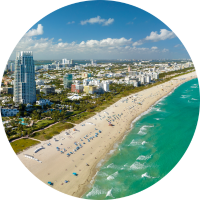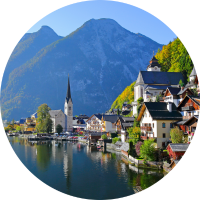Ready for the adventure of a lifetime? Exploring the world solo can be one of the most freeing and fulfilling experiences. It lets you set your own pace, discover yourself, and meet people along the way. But as exciting as it is, safety often looms large in the minds of solo adventurers.
The good news for your go-it-alone getaway? There are destinations that not only dazzle with beauty and culture but also prioritize safety for those exploring on their own. To help you plan your next adventure, we’ve rounded up ten of the best solo travel destinations for a safer vacation.
1. Reykjavik, Iceland
Reykjavik is not only Iceland’s capital but also one of the safest cities worldwide. Known for its low crime rates and welcoming atmosphere, Iceland ranks consistently high on global safety indexes — making it one of the safest countries to travel solo.
In this compact and walkable city, you can feel comfortable enjoying colorful streets, cozy cafes, and unique landmarks like Hallgrímskirkja Church on your own. Plus, Reykjavik is the gateway to Iceland’s stunning natural wonders, from lava fields to the Blue Lagoon.
2. Oslo, Norway
As a solo traveler, you’ll love Oslo’s clean streets and proximity to nature. The city’s low crime rates, high standard of living, and respectful culture make it one of the safest urban hubs for setting off on your own.
Explore world-class museums like the Viking Ship Museum or take a ferry to the picturesque Oslofjord. You can even wander through the Aker Brygge waterfront for a safe, bustling atmosphere with fresh seafood and passing ships.
3. Zurich, Switzerland
You can’t go wrong with spectacular mountain views, quaint coffee shops, and the beautiful architecture of Zurich. Switzerland’s largest city is incredibly safe and well-suited for solo travelers with its seamless public transportation, clean streets, and low crime levels.
Stroll happily on your own along the Limmat River, visit art galleries, or hike the nearby Uetliberg mountain. Zurich is also famous for its efficiency and welcoming environment, making it easier to explore alone.
4. Wellington, New Zealand
New Zealand ranks high on the list of best solo travel destinations for women and all adventurers. Known for its friendly locals and casual vibe, you’ll feel right at home in Wellington.
This cultural hub is surrounded by nature, so you can hike to the summit of Mount Victoria, stroll along the scenic waterfront, and sunbathe on beautiful beaches. Plus, Wellington is a great site for exploring Māori culture or enjoying street art and live music on Cuba Street. If you’re a film enthusiast, don’t miss touring Weta Workshop, the creative studio behind the visual effects and props for movies like “The Lord of the Rings” and “Avatar.”
5. Bali, Indonesia
Thanks to its welcoming atmosphere, budget-friendly options, and diverse activities, Bali is one of the best solo travel destinations. The island’s friendly locals and thriving traveler community make it easy to connect with others or enjoy peaceful solitude.
In Bali, you’ll find stunning temples like Uluwatu and Besakih, breathtaking beaches such as Seminyak and Nusa Dua, and opportunities to immerse yourself in local culture at traditional dance performances and bustling markets. With its mix of spirituality, natural beauty, and vibrant nightlife, you can soak in Bali safely when you travel solo.
6. Barcelona, Spain
Offering a vibrant mix of culture, stunning architecture, and seaside charm, Barcelona makes our list of the best solo travel destinations in Europe. The city is highly walkable, and its efficient public transportation makes getting around a breeze. Locals are friendly and welcoming, adding to the city’s warm and inclusive atmosphere.
With attractions like the iconic Sagrada Família, Park Güell, and the sunny Barceloneta Beach, Barcelona’s effortless combination of culture, relaxation, and adventure can make for an unforgettable solo trip to Spain.
7. Copenhagen, Denmark
Copenhagen feels like it was designed with solo travelers in mind. This bike-friendly, eco-conscious city scores high in safety and happiness. With relaxed, welcoming vibes, it’ll be easier for you to settle in and enjoy as an independent adventurer.
Take in some hiking, visit the popular amusement park at Tivoli Gardens, or sign up for a guided cycling tour around the city. From Copenhagen’s iconic wooden ships to its vibrant Nyhavn district, there’s no shortage of sights to see in its safe environment.
8. Kyoto, Japan
Japan is renowned for its safety, and Kyoto ups the charm with its iconic temples and picturesque gardens. Its mix of ancient tradition and modern safety make it a haven for those seeking serenity — and one of the best solo female travel destinations.
Whether you’re exploring the iconic Arashiyama Bamboo Grove or strolling along the Philosopher’s Path, you’ll find Kyoto to be as calming as it is captivating. The city is perfect for exploring by foot or bike, and its efficient public transit makes it easy to get around without worry. If you need help while traveling in Japan, locals are polite and will often offer assistance if needed.
9. Munich, Germany
Known for its orderly vibe and warm Bavarian culture, Munich is one of the best solo travel destinations in Europe. The city’s low crime rates and welcoming community make it especially reassuring if you’re traveling alone in Germany.
You can enjoy walks through the dreamy English Garden, tours of impressive castles like Nymphenburg, and the vibrant energy of Rathaus. Whether you’re into rich history, tasty food, or outdoor adventures, Munich has something for every solo explorer.
10. Dublin, Ireland
Easy to explore on foot and brimming with lively culture, Dublin is a great choice for solo adventurers. The famed Irish hospitality means you’ll receive a warm welcome wherever you go, and the friendly English-speaking locals are always happy to help.
From the literary walking tour of the UNESCO City of Literature to the gorgeous architecture of Dublin Castle, there’s plenty to offer for the lone explorer in Ireland. Stop by the Guinness Storehouse, enjoy live Irish folk music, or walk through St. Stephen’s Green.
The best solo travel destinations are safer with travel insurance
Don’t let fear get in the way of a solo adventure — enjoy your freedom and help protect your finances with solo travel insurance. From coverage you can count on to 24/7 travel assistance, we’re here to help. Get a quote now.




